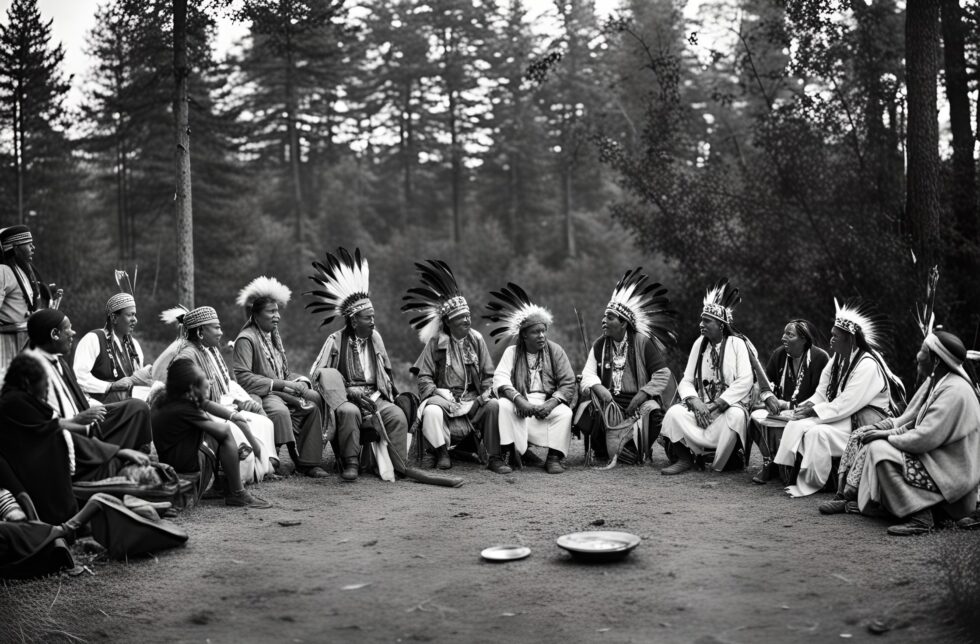
In the early 16th century, as European settlers began to establish a presence on the shores of the New World, a remarkable transformation unfolded among the indigenous tribes of North America. Initially, the arrival of Europeans, with their unfamiliar customs, weapons, and diseases, was met with curiosity and cautious hospitality. However, as settlers expanded their territories and imposed their ways, indigenous peoples faced an existential threat to their lands and way of life.

In this alternate timeline, a visionary leader emerged from the Iroquois Confederacy: a woman named Ayonwaehs, whose name meant “Beautiful Flower.” Renowned for her wisdom and ability to unite people, Ayonwaehs traveled tirelessly across the vast lands—from the forests of the Northeast to the plains of the Midwest and the deserts of the Southwest—speaking to leaders of various tribes. Her message was simple yet profound: only through unity could they preserve their lands, cultures, and autonomy.
Ayonwaehs’s charisma and foresight inspired a great council, a gathering of tribal leaders from across the continent. This council, held on the banks of the mighty Mississippi River, was unprecedented in its scope and ambition. Leaders from the Sioux, Cherokee, Apache, Navajo, and dozens of other tribes came together, bringing with them the hopes and fears of their people. After days of deliberation, they formed the Great Alliance, a coalition bound by a shared commitment to resist the encroachment of settlers and protect their way of life.
The Great Alliance was not merely a military coalition; it was a cultural renaissance. The tribes exchanged knowledge, traditions, and innovations, creating a vibrant tapestry of shared wisdom. They developed new agricultural strategies, combining the Three Sisters method of the Iroquois with the advanced irrigation techniques of the Pueblo peoples. They also formed a network of communication and trade, linking distant communities and fostering a sense of unity and purpose.

As European settlers pushed further inland, they encountered formidable resistance. United under the Great Alliance, the tribes coordinated their defenses and launched strategic counterattacks. They used their intimate knowledge of the land to their advantage, employing guerrilla tactics that confounded European forces. The settlers, accustomed to traditional European warfare, found themselves outmaneuvered and outwitted by the indigenous warriors.
The alliance’s resistance was not solely based on warfare. Ayonwaehs and other leaders recognized the importance of diplomacy and negotiation. They engaged in talks with European powers, leveraging their unity to secure treaties that recognized their sovereignty and established clear boundaries. Although these treaties were not always honored, they served as a basis for future negotiations and a testament to the tribes’ resilience and determination.
As the years passed, the Great Alliance grew stronger, and its influence extended beyond the continent. The united tribes became a powerful force in the global arena, engaging in trade with European nations on their own terms. They exported goods such as maize, tobacco, and furs while importing metal tools, firearms, and other technologies. This exchange of goods and ideas enriched both cultures, leading to a unique blend of indigenous and European influences.
The impact of the Great Alliance was profound and far-reaching. The tribes retained control over vast territories, preserving their cultures and traditions for future generations. The alliance also inspired other indigenous peoples around the world to unite and resist colonial powers, sparking a wave of decolonization movements that reshaped the global landscape.
In the centuries that followed, the Great Alliance evolved into a confederation of sovereign nations, each with its own government and cultural identity, yet bound by a shared commitment to cooperation and mutual respect. This confederation played a pivotal role in the development of North America, contributing to a rich and diverse tapestry of cultures and societies.




